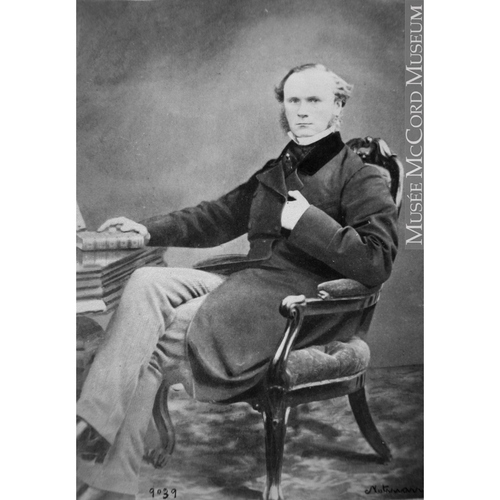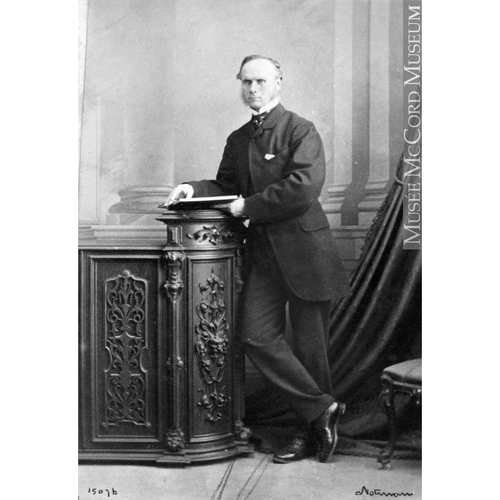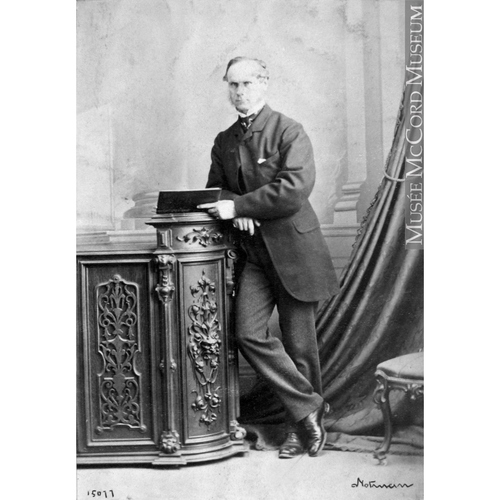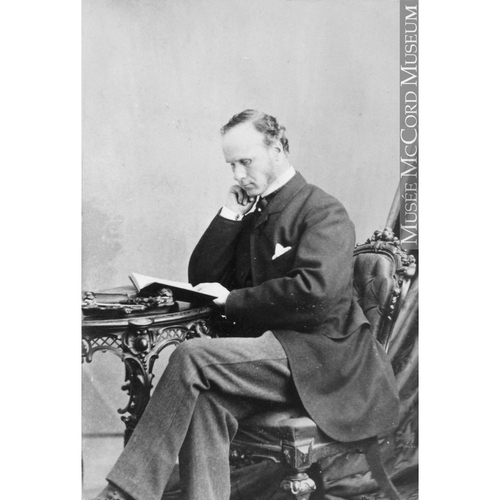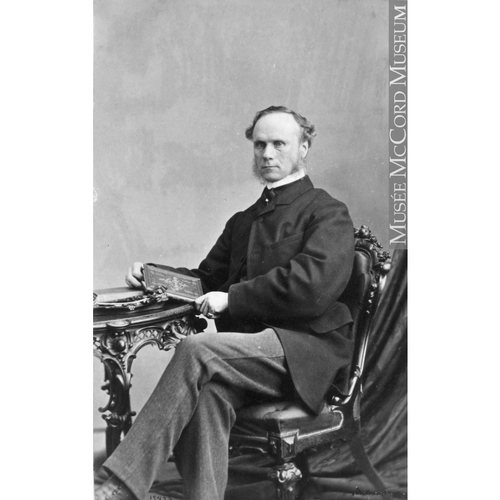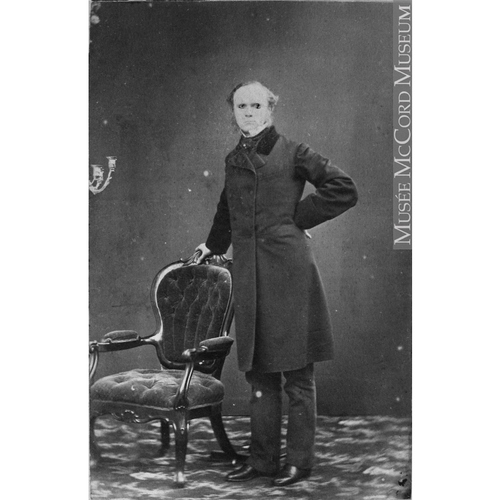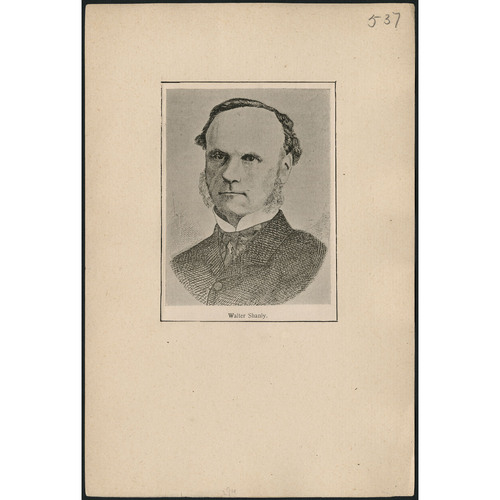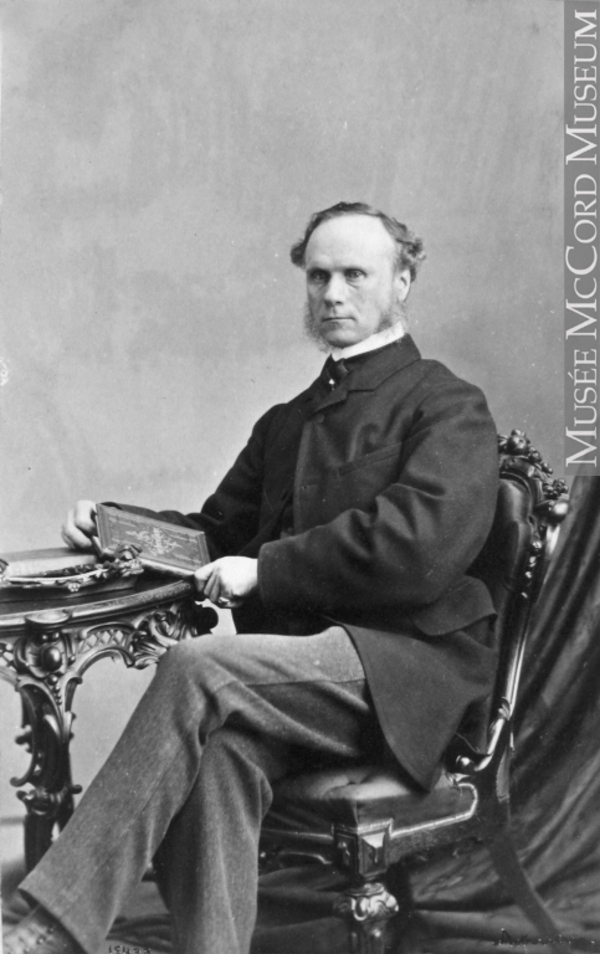
Source: Link
SHANLY, WALTER, civil engineer, author, businessman, and politician; b. 11 Oct. 1817 at the Abbey, Stradbally (County Laois, Republic of Ireland), fifth son of James Shanly, barrister and estate manager, and Frances Elizabeth Mulvany; d. unmarried 17 Dec. 1899 in Montreal.
Walter Shanly was born into a modest family of the Anglo-Irish gentry. His father afforded him every educational advantage: he was guided through the complexities of Horace, Homer, and Euclid by no fewer than six private tutors. In Dublin, during the winter of 1835–36, he was enrolled in a drawing academy and attended lessons from a French master and lectures in chemistry. Although he enjoyed a privileged upbringing at the Abbey and later at Norman’s Grove, near Dublin, the premature deaths of his mother, two brothers, and a sister, and the callous tutorship of Henry Bernard Carpenter, cast a tinge of pathos over his early years.
In May 1836 the family immigrated to Upper Canada. By 1837 they were firmly ensconced on a property, Thorndale, on the Thames River near London. Walter, in his own words a “handy-man and carpenter by gift,” took an active part in constructing the homestead. But he soon feared stagnating amidst stumps, “unlettered boors,” and manual toil. A farm hardly seemed a congenial environment for a “young fellow with a fairly logical mind and a fair amount of mathematical teaching.” He was not the only member of the family eager to shake the dust of Thorndale from his boots: his brothers Francis* and Charles Dawson* also forsook the farm.
The friendship between the Shanly and Killaly families in London became Walter’s spring-board to a career in civil engineering. Hamilton Hartley Killaly*, the chief commissioner of the Board of Works, which had jurisdiction in both Upper and Lower Canada, found in Shanly a willing recruit for his field staff. In October 1840 Shanly set out for Montreal with Killaly, his “professional Godfather.” For the next five years he divided his time between Montreal, the Saint-Ours lock on the Rivière Richelieu, and the Beauharnois Canal. Canal construction provided important experience for Shanly, but hydraulic engineering was only a stopgap. “I care little,” he wrote in June 1846, “if I can only be kept going until some of the Railroads are fairly started.” Later that summer he was offered the superintendence of an extensive line of roads in the Eastern Townships, but he demurred. Instead, he quitted his post at the Beauharnois Canal and relocated at Port Robinson, Upper Canada, to participate in the reconstruction of the Welland Canal by the Board of Works.
Shanly, who disliked being anchored in one spot, soon cast about for other employment. After assessing the “hum-drum” prospects of the Great Western Railway, in the autumn of 1848 he leapt at a position on the Ogdensburg and Lake Champlain Railroad, where Francis had been hired as an assistant engineer, and the brothers were spurred on by a resolve “to fit themselves for the coming Railway Era in their own country.” Their sojourn in northern New York proved enriching: it initiated Walter into “all the mysteries of laying down rails.” But the acquisition of such expertise was seldom tempered with humility; in March 1849 he crowed, “In common roads and Canals I know as much as most white men & where Plank Roads are in question more than any man in the State.” However, the Vermont legislature’s rejection in April of his design for a bridge spanning Lake Champlain at Rouses Point left him in a state of dejection.
In June Shanly’s spirits were lifted by his promotion to the post of resident engineer of the western division of the Ogdensburg railroad. Always the unrelenting taskmaster, he set a vigorous pace of construction for his 60 miles of track. Upon its completion in July 1850 he realized he had no permanent place in Ogdensburg and anxiously looked back to the Province of Canada, then astir with railway fever. “Less than a Chiefship, I wont take there,” he announced emphatically to Francis in December. “If I must be a beggarly assistant all my life, let it be in these d–d United States.”
In January 1851 Shanly returned to supervise the construction of the Bytown and Prescott Railway. Plans for a line linking Bytown (Ottawa) to markets in Montreal and the northeastern United States had been voiced as early as 1848, and the completion of the Ogdensburg railroad made such talk more meaningful. Negotiating a wage of £600 that left the directors reeling, Shanly resolved to “show the Canada folk how quickly Railroads can be built when they get the right man at them.” For the next three months, with only a compass and two axemen, he surveyed the swampy expanse between Prescott and Bytown on snowshoe. Shanly’s work as chief engineer, however, soon left him disgruntled. His disappointment became more acute when he learned of the appointment of his arch-rival, Thomas Coltrin Keefer*, as chief engineer of the Montreal and Kingston Railway. News of Keefer’s rising professional fortune made him feel ‘“kind of small,’” he told Francis in April, and his Bytown–Prescott endeavour seem rather trivial. Progress on the Bytown and Prescott was slow, leaving Shanly to nurture the hope in October that Sir Allan Napier MacNab* would secure a lucrative foothold for him on the Great Western. In March 1853, despite his optimistic vow to complete the Bytown–Prescott line by 1852, the road-bed was still bare of rails. A chronic shortage of money haunted the company and dictated that the line be as short and as cheap to build as possible.
Nevertheless, as Shanly’s international reputation had spread, he was besieged with invitations. In October 1851 he rebuffed a delegation who wanted him to survey a railway route between Prescott and Georgian Bay, and in 1853 he was to decline the chief engineership of the Alleghany Valley Railway. One offer, however, proved irresistible: chief engineer of the Toronto and Guelph, for which C. S. Gzowski and Company was the contractor. In 1852, while still engaged on the Bytown and Prescott, Shanly, joined by Francis as principal assistant engineer, surveyed routes between Toronto and Guelph. The following year the railway was bought by the Grand Trunk. It extended the line to Sarnia, retaining the Gzowski firm as builder and Walter Shanly as chief engineer. He worked closely with Casimir Stanislaus Gzowski during the entire construction (1853–56), and the high standards of their collaboration were impressive. They brought their technical skills to bear on mastering bridge construction, using solid, massive structures of masonry and iron instead of small, timber trestle-works. These bridges, admired by the architect and railway engineer Frederic William Cumberland*, epitomized Shanly’s engineering credo about the inseparable alliance of utility and aesthetics.
Throughout the 1850s Shanly was immersed in a myriad of activities and overlapping projects. In January 1853 he published a report on the location of the Grand Trunk’s Toronto depot, advocating an extensive esplanade to preserve the waterfront from ugly commercial exploitation. In 1854 – by May he had left the floundering Bytown and Prescott Railway – he surveyed a new section of the Welland Canal, as well as the route of the Port Whitby and Lake Huron Railway. His report on the Port Huron and Lake Michigan Railway went to press that same year. In September 1855 he was called upon by the Great Western to arbitrate on prices for building a double track. The following year he undertook the reconnaissance of a proposed line of navigation from Montreal to Lake Huron via the Ottawa and French rivers. This project struck Shanly as “bold” and costly, but he spared no pains to draft several feasibility reports. His charts, he hoped, would match in accuracy and artistry those of the famous hydrographer Henry Wolsey Bayfield* .
Although he had few idle moments, Shanly craved more advancement and celebrity. Despite his early conviction that “no credit” could come to anyone connected with the poorly administered Grand Trunk, Shanly moved to Montreal and in January 1858 became general manager and chief engineer of that railway, the longest in the world. He was only 40. His four-year term was marked by vigilance and hard work but was blighted by accusations of land speculation, corruption, and extravagance, allegations he did not take lightly. The findings of provincial auditor John Langton and his committee of inquiry in 1861 elicited from Shanly a blistering rebuttal. One of the few compensating highlights of his association with the Grand Trunk was the Prince of Wales’s visit in 1860 to inaugurate the Victoria Bridge in Montreal, which had been designed by the famed British engineer Robert Stephenson and built under the direction of James Hodges*.
Resigning in June 1862, Shanly withdrew from the cross-fire of railway-building politics and returned to his Prescott farm. (He had first acquired property in the area in 1853.) He took with him a handsome testimonial signed by the 3,000 men of the Grand Trunk. Briefly he mused about a quiet niche in the United States, in charge of a railway “about 100 miles long, salary $2,000.” However, in 1863 he entered politics, a move that was more of a step than a leap, since politics and railways during the mid 19th century were inextricably linked. Shanly, described as a Liberal-Conservative, defeated William Patrick* in June in the Reform stronghold of Grenville South. His political style had little of the compelling or the charismatic. The Brockville Recorder ascribed his success more to “large promises” and free railway tickets than to personal attributes. But according to James Reynolds, a Prescott barrister, Shanly possessed the requisite credentials; after all, he was a “first rate clever Irishman with lots of cash & a bachelor ‘to boot.’”
Upon taking his seat in 1864, Shanly, who would prove to be a diligent mla, was named to the assembly’s railway committee. In 1865 he, Joseph Howe*, John Young*, and Donald McInnes were among the British North American delegates to the international convention of boards of trade in Detroit. During the confederation debates that year Shanly cast his vote for union, but not without qualification. He expressed doubts about the colonization of the northwest and the federal concept, and contended that commercial relations should be cultivated among the provinces before a political alliance was established.
In 1867 Shanly entertained serious reservations about running again. Nevertheless, submitting to party pressure, he did run, and he sat in the House of Commons from 1867 to 1872. Although shyness kept him from taking a prominent part in the debates, he rose to his feet from time to time as an exponent of railway interests and starch-manufacturing, in which he had become involved. On occasion he criticized the profligacy of the Intercolonial Railway, reviled government ownership of railways, and defended the principle of a standard, universal gauge. On the subject of canals he was sometimes moved to copious oratory. In the spring of 1870, for example, he advocated the enlargement of the Canadian canal system, envisioning a continuous ten-foot-deep “Ship Canal” from Montreal to Lake Nipissing.
During the 1860s politics did not wholly monopolize Shanly’s energies. In mid decade he advised contractor John Worthington on the restoration of the stone fortifications at Quebec. During 1865–66 he investigated the possibility of the Grand Trunk’s acquiring the charter of the St Paul and Winona Railroad. In the spring of 1868 Montreal City Council consulted Shanly about improving the local waterworks. Throughout the decade he was an increasingly visible member of a group of Montreal business speculators. He invested in both the Canada Peat Fuel Company and the Kennebec Gold Mining Company. In 1866 he began a 20-year term as president of the Edwardsburg Starch Company, located near Prescott [see William Thomas Benson*]. He even took on the role of financier in 1865 as president of the Mechanics’ Bank of Montreal.
Shanly’s engineering career was only temporarily eclipsed by his business and political obligations. An invitation in 1868 to tender on completing a railway tunnel through the Hoosac Mountains, in northwestern Massachusetts, would culminate in his greatest achievement. The tunnel, presenting a special challenge, offered a chance to renew the Shanly brothers’ partnership and to rekindle Walter’s engineering skills. The 4½-mile tunnel was a formidable project, demanding Herculean effort against loose rock and clay, seeping water, and poisonous vapours. Since the 1850s the Hoosac, the “first really large-scale tunneling enterprise” in North America, according to historian Archibald Black, had defeated American engineers. However, construction pushed ahead vigorously with Walter and Francis Shanly, engineers-cum-marshals, leading an assault supported by the revolutionary technology of pneumatic drills, steam-powered air compressors and elevators, and nitro-glycerine, and by almost 900 men and boys.
In 1871, after Francis had returned to Canada, Walter was exclusively involved with the Hoosac Tunnel as its resident engineer. Other concerns receded as he pressed on to meet his contractual deadline in 1874. His single-minded preoccupation with the Hoosac led to such a cursory supervision of his construction of the Midland Railway from Beaverton to Midland in Ontario, for which he had tendered in January 1872, that his contract was cancelled in February 1873. Even plans for the Pacific railway barely figured in his thoughts. Shanly cautiously distanced himself from the debate on that project, pleading lack of time and capital. But the monumental concept also intimidated him; as he confessed to Sir John A. Macdonald in January 1873, “It may be that the ‘Pacific’ is too big a thing for me.” The following month, however, the Canada Gazette announced his appointment to a directorate to supervise its construction and financing. The directorate was short-lived, a casualty of the Pacific Scandal, but Shanly emerged unscathed.
Shanly’s lengthy absences from Grenville South because of the Hoosac construction proved costly. Fully aware that the Roman Catholic vote was arrayed against him and resigning himself to defeat in the election of 1872, he had lingered in North Adams, Mass. After a bout of deafness he put in a last-minute appearance to canvass his constituents in July. In August the Brockville Recorder accused him of having “misrepresented” the riding. That month he lost to William Henry Brouse*. Macdonald dashed off some words of consolation: “The blow to the party will be felt all through Ontario.” Shanly was defeated again by Brouse in the general election of January 1874.
By November 1874 the Hoosac Tunnel was largely finished. Shanly rid himself of that albatross, only to face a sequence of monetary set-backs and personal trials. In 1879 the Mechanics’ Bank, in which he was a prominent shareholder, plummeted into bankruptcy. Even more distressing were the financial reverses of his brother Francis. Walter rescued him from his creditors and shouldered the burden of his liabilities. Following Francis’s untimely death in 1882, his sense of fraternal responsibility deepened and he importuned Macdonald in April 1883 to provide a pension for his brother’s widow: “This is the nearest I have ever come to asking anything of the Government for myself.”
Often out of pocket, Shanly was seldom out of energy. Even while he aged, his career showed few signs of faltering. In 1876, as the Halifax and Cape Breton Railway and Coal Company, he and Edmund W. Plunkett vied unsuccessfully against Sir Hugh Allan* and Harry Braithwaite Abbott to construct a line in Nova Scotia from New Glasgow to Louisbourg, the proposed eastern extension of the Intercolonial Railway. The firm did, however, win the contract for the Western Counties Railway, also in Nova Scotia. Frequently called upon to serve as a consultant, Shanly had been retained in 1874 by the Caughnawaga Ship Canal Company and in July 1877 by the Quebec, Montreal, Ottawa and Occidental Railway. From 1879 he served as chief engineer of the Canada Atlantic Railway, built initially from Ottawa to Coteau-Landing, Que. About the same time he assumed management of “his first Railway Child,” the St Lawrence and Ottawa, formerly the Bytown and Prescott. In the last three positions, he left his mark as the engineer of a major component of the railway system radiating from Ottawa. Shanly was consulted in 1880 regarding the layout of the Credit Valley Railway and two years later he was invited by the directors of the Napanee, Tamworth and Quebec Railway Company to inspect and report on the road-bed and works of their projected line. In 1889 he and Gzowski joined forces to grapple with the much-debated disposition of Toronto’s waterfront adjacent to the CPR freight-yard. The expertise he gained from the Hoosac experience did not lie dormant. In 1881 he explored the prospects of a tunnel between Hochelaga (Montreal) and Longueuil; in 1886 his opinion was sought by the federal government regarding the viability of a tunnel to Prince Edward Island. Later in the decade he surveyed the St Clair River preparatory to the construction of a tunnel. Commission work also engrossed Shanly’s attention: in May 1886 he joined a federal royal commission investigating the cause of floods at Montreal, and five years later he assisted in discussions over the enlargement of the Cornwall Canal.
Shanly had returned to the political arena in 1885, upon the death of Grenville South’s Conservative incumbent, William Thomas Benson. He was elected by acclamation to the commons, where he remained until 1891, urging improvements to Canada’s internal navigation system and promoting railway interests. His political performance during these years was indifferent. Once again Grenville South suffered conspicuous neglect from its absentee representative, who resided in Montreal and seldom bestirred himself for even a token appearance among his constituents.
Despite the fact that he was in his eighties, Shanly’s professional services were still in demand by the late 1890s. In 1899 he single-handedly arbitrated a dispute between the federal government and the firm of Hugh Ryan over construction costs of the Sault Ste Marie Canal. (The Railroad Gazette later noted that Shanly was not an innate collaborator: he “never would consent to sit in an arbitration with anyone else. His reliance on his own judgment was absolute.”) As old age encroached, Shanly devoted time to compiling his memoirs, family memorabilia, and a genealogy. On 17 Dec. 1899 he died at St Lawrence Hall, an exclusive hotel in Montreal. He was buried in the family plot at St John’s Cemetery (Anglican) at Arva, near London.
Walter Shanly was very much the embodiment of the earnest-minded, intellectually curious Victorian gentleman. Imbued with a belief in technology’s bounties, he was a typical spokesman for his era. More important, his career paralleled, and he was a vital agent in, the professionalization of civil engineering in Canada. An early member of the Canadian Institute, he was instrumental in establishing an engineering school at McGill College in 1857 [see Sir John William Dawson] and in incorporating the Canadian Society of Civil Engineers in 1887 (he served as its first vice-president). In his lifetime Shanly witnessed the evolution of the technology of railway building in North America. As an engineer, he possessed expertise, inventiveness, single-mindedness, and rectitude of purpose of the first order. His exacting management and detailed reports won widespread admiration. So too did his skill at arbitration.
As a politician, Shanly was less dazzling. His commitment to politics seemed hesitant. In 1872 the captious Prescott Telegraph characterized him as a tory automaton, voting with “machine-like regularity” for Conservative policies. Two years previously the Canadian Illustrated News had provided a more charitable assessment, applauding his high personal and professional standing, integrity, and “spirit of independence.” Shanly prided himself on being unbound by political allegiance and party fealty. Although he was unobtrusive as a public figure, there is little doubt that the Macdonald government considered his conversancy with railway management a decided asset. Macdonald, who esteemed Shanly a friend and an ally, frequently solicited his advice.
Although Shanly was a private man, he enjoyed life. At times he yielded to his fondness for alcohol, horses, and sartorial pretension. During the 1840s he revelled in the delights of “jolly” Montreal and in the feminine charms of the “Niagara Muffins.” However, as career obligations mounted, his life became consumed by estimates, surveys, and contracts. His letters, once filled with bonhomie, grew testy and hectoring. A compulsive worker, he often pushed himself to the brink of exhaustion. Even his sedentary hours were occupied with some useful activity. He read extensively and from 1849 wrote anonymous editorials for Punch in Canada (Montreal). He played seriously his role in loco parentis to his half-sister, Ellen, 16 years his junior. He was no less solicitous towards his brother Francis and his impecunious family.
Those who met the tall, fair-complexioned, spare, and athletic Shanly saw in his piercing eyes, stern mouth, and dignified demeanour an extraordinary force of character. According to the Science record in 1872, one acquaintance contended that he was living proof that the “Irish gentleman is not wholly a creature of the imagination.” Francis was liked for his simplicity of character, honesty, and goodness. Walter commanded respect rather than friendship. Proud, blunt, opinionated, he was given to personal pique and professional jealousy. Americans, Orangemen, Catholics, and rival colleagues all fell within the range of his verbal trajectories. His relationships with his staff, and even railway investors, were marked by high-handed arrogance. He kept his subordinates at an “immeasurable distance” and, as he confided to Francis in a discussion of the Bytown and Prescott, expected the company’s directors to conduct themselves with “a wholesome awe of me and . . . with proper and becoming humility.” Even his tone with his brother when they worked together was magisterial. In short, Shanly deemed it his prerogative as a civil engineer to do “as I d–d please.”
In clouded moments of introspection, the ageing Shanly reflected bitterly on his career. His life, he wrote in his “Memoirs” in 1896, had been a chequered journey, “studded with regrets.” He resented the toilsome hours that had rendered his existence “dull, colourless [and] laborious.” Men like Sir William Cornelius Van Horne* and Gzowski dramatically illustrated the prestige, honours, and material rewards that could flow from engineering endeavours. On the eve of his death Shanly calculated his net assets to be only $28,697, which struck him as a modest tally “after nearly sixty years of fairly honest work.” “Failure,” he concluded in his memoirs, was the “simple monosyllabic epitaph” he deserved. There were, however, more tangible and reliable indications of his accomplishments. His legacy was preserved not only in steel and stone but in a scattering of places bearing his surname throughout Ontario. In his lonely self-colloquy, Walter Shanly completely undervalued the significance of his life.
[Walter Shanly left behind a considerable collection of personal papers. A useful, but rather sanitized, selection of his letters has been published in Daylight through the mountain: letters and labours of civil engineers Walter and Francis Shanly, ed. F. N. Walker ([Montreal], 1957), which also reprints in part the memoirs from his papers in AO, MU 2719–22, 2730–32.
During his career, Shanly prepared many professional reports; they were characterized by their lucidity and frank scrutiny. Listings of his publications appear in CIHM Reg., Canadiana, 1867–1900, the National union catalog, the NA’s Catalogue of pamphlets (2v., Ottawa, 1931–32), and the General index to the journals of the Legislative Assembly of the province of Quebec . . . 1867–1887, comp. P. E. Smith (Quebec, 1891). l.c.c.s. and j.d.b.]
AO, MU 2385–87. McCord Museum, M22087. NA, MG 26, A. St Patrick’s Church (Stradbally, Laois, Republic of Ire.), Reg. of baptisms, 1772–1825, 18 Nov. 1817. UWOL, Regional Coll., Middlesex County, Ont., Surrogate Court, will no.6728 (mfm. at AO); Shanly family papers, boxes 4296–97, 4300. Can., House of Commons, Debates, 1867–68, 1870, 1885–89. Can., Prov. of, Commission appointed to inquire into the affairs of the Grand Trunk Railway, Report (Quebec, 1861); Parl., Confederation debates. Canadian Architect and Builder (Toronto), 13 (1900): 3. Canadian Engineer (Toronto), 7 (1899–1900): 259. Canadian Soc. of Civil Engineers, Trans. (Montreal), 14 (1900), pt.i. “The Hoosac Tunnel,” Franklin Institute, Journal (Philadelphia), 3rd ser., 61 (1871): 145–48. “The Hoosic Tunnel,” The science record . . . ; a compendium of scientific progress and discovery (5v., New York, 1872–76), 1: 170–90. Myles Pennington, Railways and other ways: being reminiscences of canal and railway life during a period of sixty-seven years . . . (Toronto, 1896). Railroad Gazette (Chicago), 22 Dec. 1899, 23 March 1900. Sentinel (Toronto), 21 Dec. 1899. Brockville Evening Recorder, 1885, 18 Dec. 1899. Brockville Recorder, June 1863, 15 Aug. 1872. Canadian Illustrated News (Montreal), 23 April 1870. Daily Mail and Empire, 18 Dec. 1899. Evening News (Toronto), 18 Dec. 1899. Globe, 18 Dec. 1899. London Advertiser, 20 Dec. 1899. London Free Press, 20 Dec. 1899. Monetary Times, 28 Feb. 1879. Montreal Daily Star, 18 Dec. 1899. Montreal Herald, 18 Dec. 1899. Ottawa Evening Journal, 19 Dec. 1899. Prescott Telegraph (Prescott, Ont.), 18 July 1872. Standard (Napanee, Ont.), 11 Nov. 1882. Toronto World, 18 Dec. 1899. Canadian men and women of the time (Morgan; 1898). CPC, 1889. Cyclopædia of Canadian biog. (Rose and Charlesworth), vol.1. William Notman and [J.] F. Taylor, Portraits of British Americans, with biographical sketches (3v., Montreal, 1865–68), 3. N. R. Ball, “Mind, heart, and vision”: professional engineering in Canada, 1887 to 1987 (Ottawa, 1987), 23–24, 27.
Cite This Article
Laurie C. C. Stanley and John D. Blackwell, “SHANLY, WALTER,” in Dictionary of Canadian Biography, vol. 12, University of Toronto/Université Laval, 2003–, accessed April 12, 2025, https://www.biographi.ca/en/bio/shanly_walter_12E.html.
The citation above shows the format for footnotes and endnotes according to the Chicago manual of style (16th edition). Information to be used in other citation formats:
| Permalink: | https://www.biographi.ca/en/bio/shanly_walter_12E.html |
| Author of Article: | Laurie C. C. Stanley and John D. Blackwell |
| Title of Article: | SHANLY, WALTER |
| Publication Name: | Dictionary of Canadian Biography, vol. 12 |
| Publisher: | University of Toronto/Université Laval |
| Year of revision: | 1990 |
| Access Date: | April 12, 2025 |


